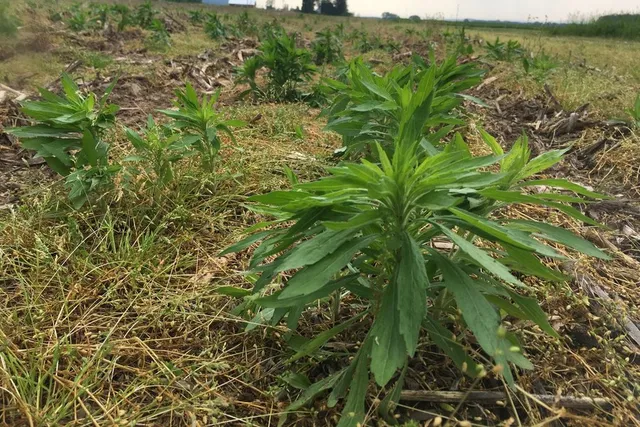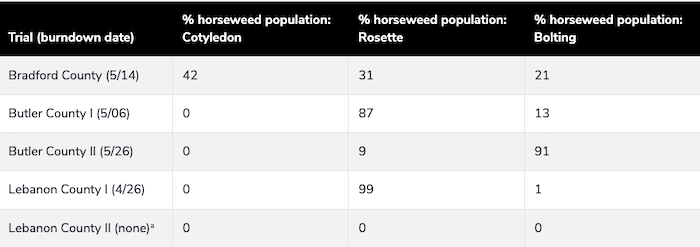In a first-year Pennsylvania Soybean Board funded on-farm project, we aimed to (1) define regional and management-driven trends in emergence patterns, and (2) evaluate preemergence herbicide programs for horseweed control, including single- and multiple- active ingredient programs. In 2022, we conducted five on-farm trials in Butler County (n = 2), Bradford County (n = 1) and Lebanon County (n = 2).
Understanding horseweed emergence patterns is the first step at designing more effective herbicide programs. A key management goal for effective control of horseweed is to target populations with pre-plant burndown applications prior to the bolting stage because the efficacy of commonly used burndown products [saflufenacil (i.e., Sharpen), 2,4-D, dicamba or paraquat] decreases after horseweed bolts. As expected, later planted soybean fields (mid- to late- May) were more likely to have horseweed plants that had already bolted (Table 1). One noteworthy finding was that the Northern Tier location was the only population that appeared to have a significant spring flush of horseweed just prior to soybean planting.
Table 1. growth stage of horseweed population prior to pre-plant burndown application (listed below).
Additional horseweed emergence after soybean planting is becoming more common and understanding this pattern can help design effective tactics for managing horseweed in crop. Our monitoring results showed significant horseweed emergence after planting at 3 of 5 locations (Table 2). Though additional sites will be needed, our first-year results suggest that the Northern Tier and western locations were more likely to have significant flushes of horseweed after planting. This finding suggests that soil-applied herbicide programs will be a key component of horseweed management in these regions.
Table 2. Emergence timing of horseweed relative to soybean planting (pre- or post- plant).
Our on-farm herbicide trials consisted of single- and multiple- active ingredient preemergence programs, including two ALS Inhibitors (Group 2; chlorimuron and cloransulam), metribuzin (Group 5) and flumioxazin (Group 14). Effective burndown applications were applied at each location but varied depending on the soybean trait. Treatments varied at each location to include each grower's program that was applied in the rest of the field. Horseweed control 30-35 days (~5 weeks) after planting is reported in . The efficacy of single active ingredients varied across locations and the lack of acceptable control levels from Group 2 herbicides in some locations may be an indicator of ALS-resistant populations, though additional studies will be needed to verify. In general, Group 2/5 mixtures provided the most consistent control.
Table 3. Horseweed control (% population reduction) 30-35 days after application
Our first-year results showed that post-plant emergence of horseweed was significant at several locations within Pennsylvania, which emphasizes the need for soil-applied residuals in herbicide programs to provide season-long horseweed control. Among residual products, the combination of FirstRate and metribuzin provided the most consistent levels of control. On-farm trials will continue in 2023 to better define regional trends in horseweed emergence patterns and herbicide program efficacy.
If you have questions or would be willing to host 2023 on-farm field trials focusing on horseweed, waterhemp, or Palmer amaranth emergence patterns and herbicide programs, please contact: John Wallace, jmw309@psu.edu, phone: 814-863-1014, text: 208-874-2887









